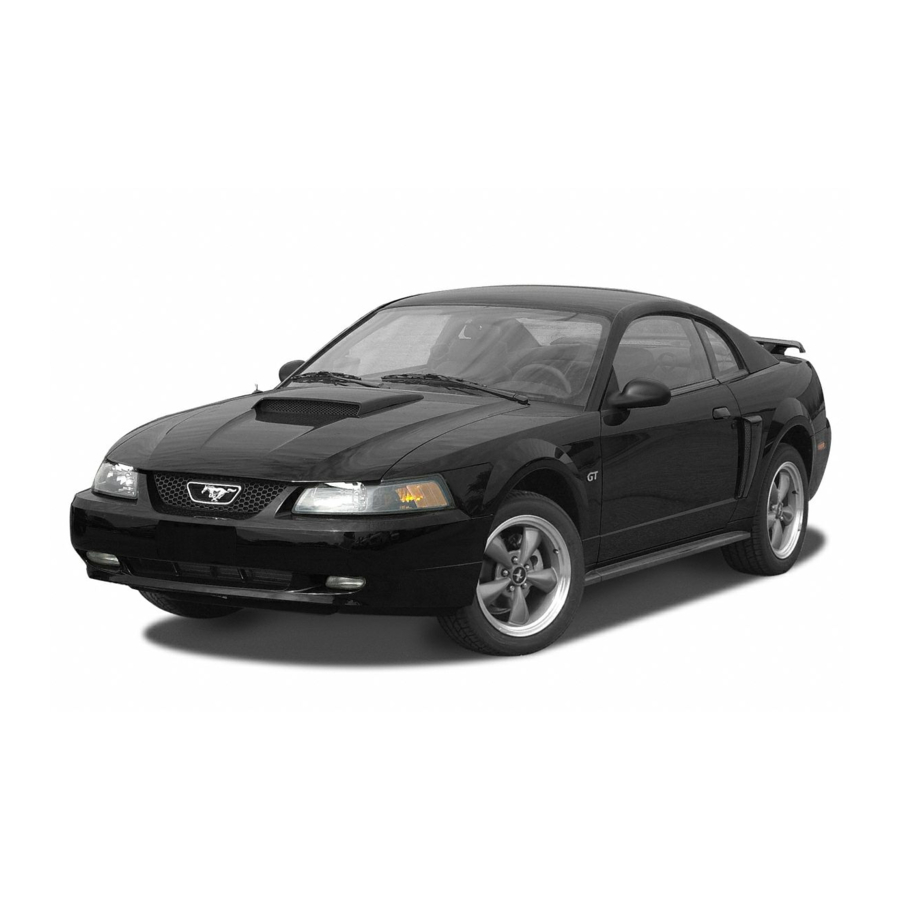
Ford 2004 Mustang Owner's Manual
Ford motor company 2004 ford crown victoria owner's guide
Hide thumbs
Also See for 2004 Mustang:
- Supplement manual (24 pages) ,
- Quick reference manual (2 pages) ,
- Owner's manual (240 pages)
Table of Contents
Advertisement
Introduction
Instrumentation
Servicing your vehicle
All rights reserved. Reproduction by any means, electronic or mechanical
including photocopying, recording or by any information storage and retrieval
system or translation in whole or part is not permitted without written
authorization from Ford Motor Company. Ford may change the contents without
notice and without incurring obligation.
Copyright © 2003 Ford Motor Company
Table of contents
2
4
5
1
Advertisement
Table of Contents

Summary of Contents for Ford 2004 Mustang
- Page 1 Ford Motor Company. Ford may change the contents without notice and without incurring obligation. Copyright © 2003 Ford Motor Company...
- Page 2 If your NGV is not maintained in accordance with approved service procedures, damage may occur and your warranty may be invalidated. Any modification to the fuel system of your NGV voids the Ford New Vehicle Limited Warranty.
-
Page 3: Compressed Natural Gas Fuel System
COMPRESSED NATURAL GAS (CNG) FUEL SYSTEM Your vehicle is equipped with a dedicated compressed natural gas (CNG) fuel system that is under high pressure. Depending upon the application, the CNG fuel system is rated at a pressure of 20,700 kPa (3,000 psi) at 21°C (70°F) or 24,800 kPa (3,600 psi) at 21°C (70°F). -
Page 4: Fuel Gauge
Instrumentation Instrumentation FUEL GAUGE The fuel gauge in your NGV behaves similarly to a typical gasoline fuel gauge. However, the gauge operation is based on the pressure and temperature of the natural gas, not on the level of liquid gasoline. Depending upon application, a fuel gauge reading of Full will occur at a pressure of approximately 20,700 kPa (3,000 psi) or 24,800 kPa (3,600 psi), at a temperature of approximately 21°C (70°F). -
Page 5: Cng Fuel System Component Identification
Servicing your vehicle Servicing your vehicle CNG FUEL SYSTEM COMPONENT IDENTIFICATION The following illustrations depict the major unique components of the CNG fuel system. All of these unique components are constructed of special materials that withstand the effects of CNG. NEVER replace a unique CNG fuel system component with a standard gasoline fuel system component or any aftermarket component. - Page 6 Servicing your vehicle E-450 Cutaway 1. Fuel rail sensors - An injection pressure sensor and an engine fuel temperature sensor provide engine fuel information to the powertrain control module. 2. Isolation solenoid valve - Blocks fuel flow from supply line to injection manifold when the engine is off.
- Page 7 Servicing your vehicle 9. Aft axle fuel tanks - Two steel fuel tanks located behind the rear axle. 10. Midship fuel tank - A steel fuel tank located underbody. 11. High pressure fuel lines - Delivers high pressure fuel to the fuel tanks and fuel pressure regulator.
- Page 8 Servicing your vehicle vehicle’s inertia switch. If the engine cranks but does not start after a collision, the fuel solenoid valve inertia switch may have been activated. The inertia switch is a device intended to close the fuel solenoid valve when your vehicle has been involved in a substantial jolt.
- Page 9 Servicing your vehicle 2. Isolation solenoid valve - Blocks flow from the injection manifold when the engine is off. 3. Engine - Is a modified 4.6L engine with Sequential Electronic Fuel Injection (SEFI) and increased compression ratio. 4. Engine coolant lines - Provide required heat to high pressure regulator.
- Page 10 Servicing your vehicle ADAPTERS DO NOT use fuel receptacle adapters when refueling your vehicle. The profiles of both the natural gas vehicle receptacle and the fuel station nozzles are specified by ANSI/AGA NGV1-1994, CGA NGV1-M94. These profiles are specified for compressed natural gas vehicles and fuel stations for safety purposes.
- Page 11 indication that refueling is nearly complete. Also, the station compression equipment may turn on at any time during the refueling process. FUEL QUALITY Do not use liquefied natural gas (LNG) or a CNG that is derived from a process such as flashing (heating LNG). Failure to use the correct type of fuel may cause damage to the engine and fuel system components.
-
Page 12: Fueling
Servicing your vehicle SERVICING YOUR NATURAL GAS VEHICLE Service to the CNG fuel system should be conducted at a qualified dealership by a trained NGV technician only. Failure to do so may cause damage to components or cause bodily harm. FUELING Do not fuel your vehicle with the ignition on the ON position. - Page 13 Use caution when fueling your vehicle. Make sure the engine is turned off and all flammable material is extinguished. Observe all Dispensing Equipment Safety Standards and Operating Procedures. The procedure is the same for both fast-fill and slow-fill fueling. 1. Open fuel door and determine the pressure rating of your vehicle’s fuel system.
- Page 14 Servicing your vehicle E-Series Cutaway 158” Wheelbase (3600 psi) Fueling Standard method tanks Slow-fill 63.2L (16.7 gallons) Fast-fill 53.8L (14.2 gallons) E-Series Cutaway 176” Wheelbase (3000 psi) Fueling Standard method tanks Slow-fill 60.9L (16.1 gallons) Fast-fill 51.8L (13.7 gallons) E-Series Cutaway 176” Wheelbase (3600 psi) Fueling Standard method...
-
Page 15: Tank Inspection/Replacement
Crown Victoria (3600 psi) Fueling method Standard tanks Slow-fill 45.0L (11.9 gallons) Fast-fill 38.2L (10.1 gallons) Police and Taxi vehicles. Extended range fuel system Crown Victoria Police and Taxi vehicles with the extended range fuel system have a 5–passenger seating configuration with one additional CNG fuel tank mounted in the luggage compartment. -
Page 16: Coalescent Fuel Filter Assembly
The purpose of the inspection is to check for exterior damage to the tank which would shorten its usable life span. This inspection should only be done by qualified NGV Ford service technicians. The expiration date for the tank replacement is stated on each tank label See instructions on fuel container for inspection and service life.






